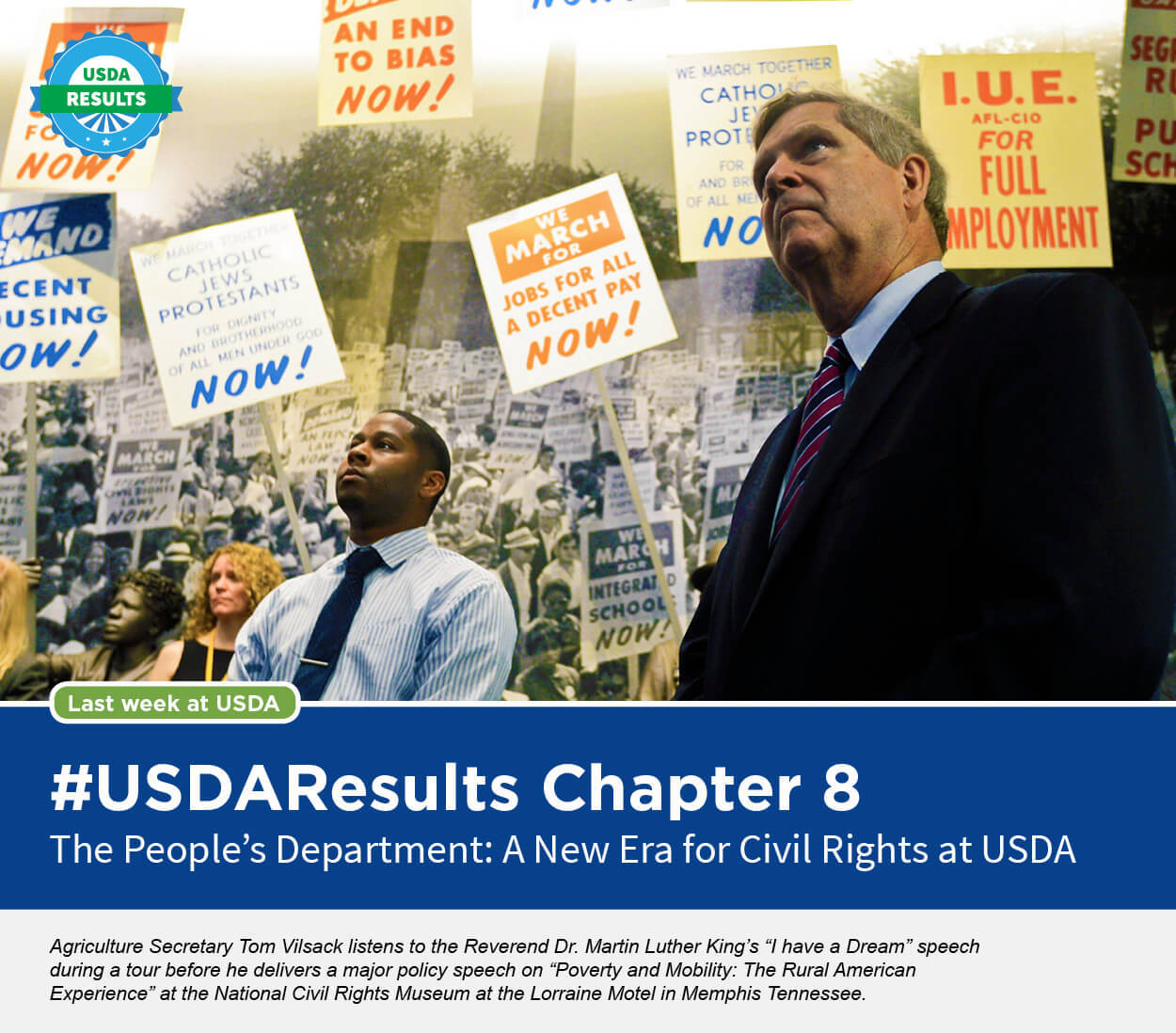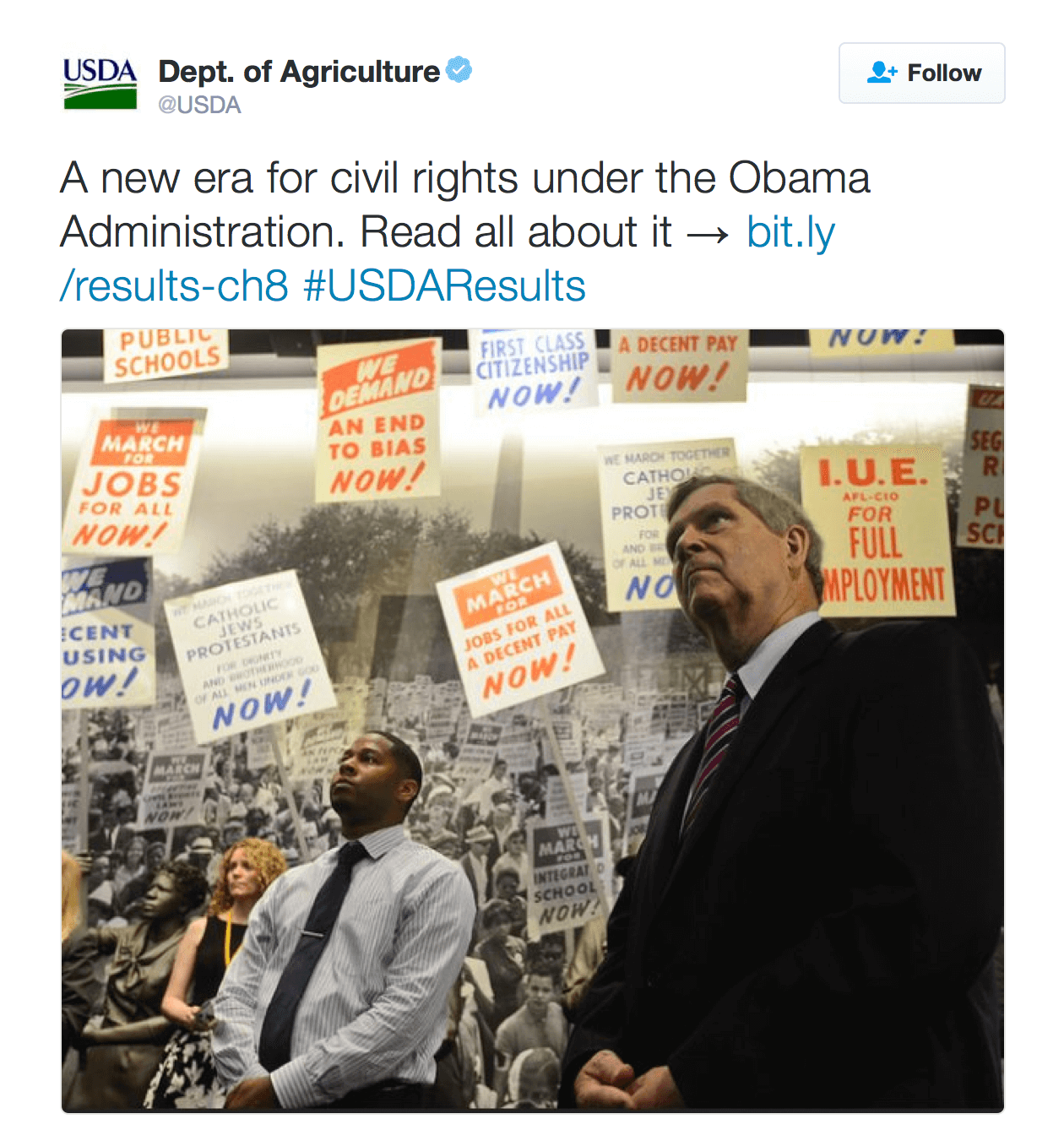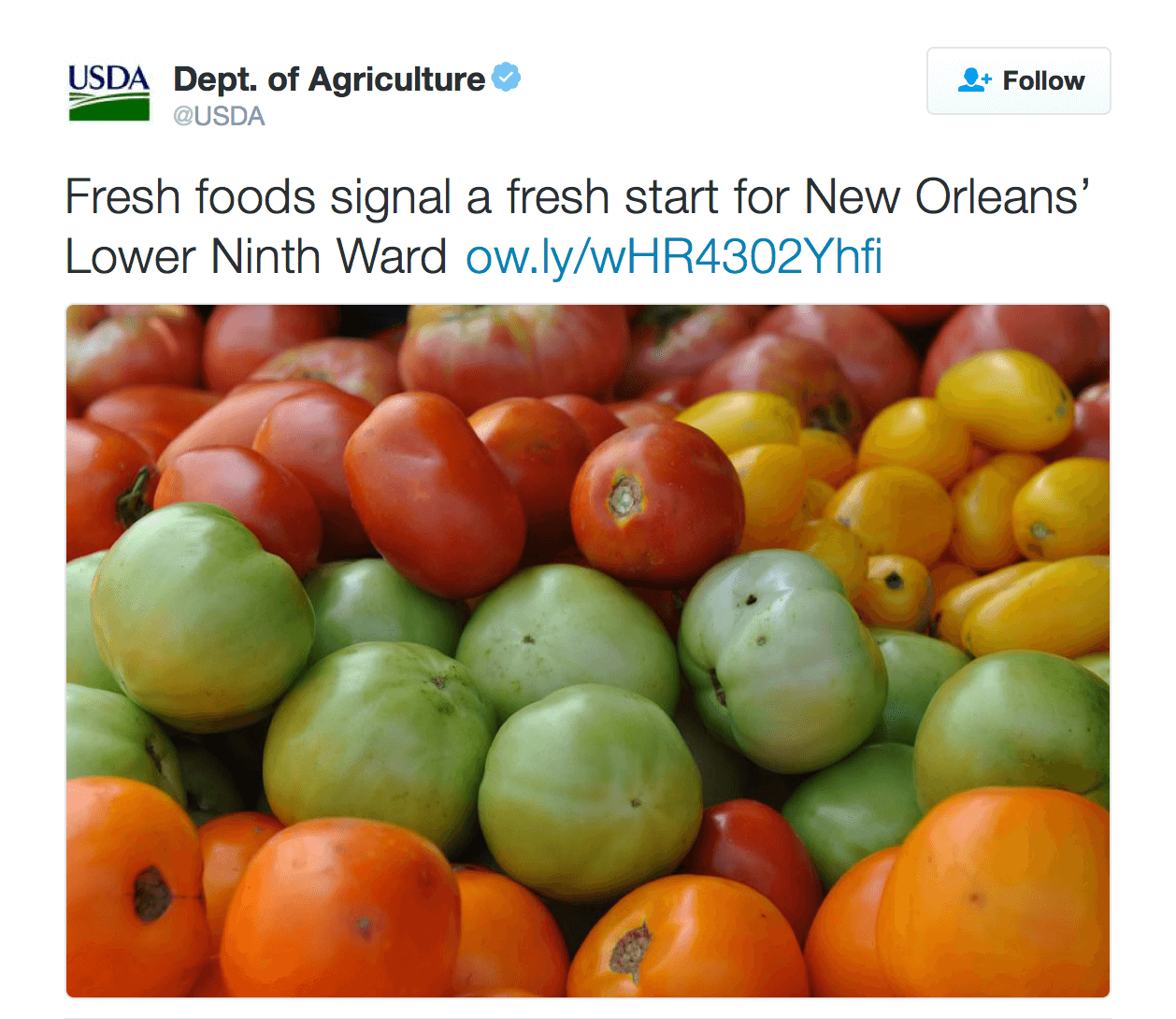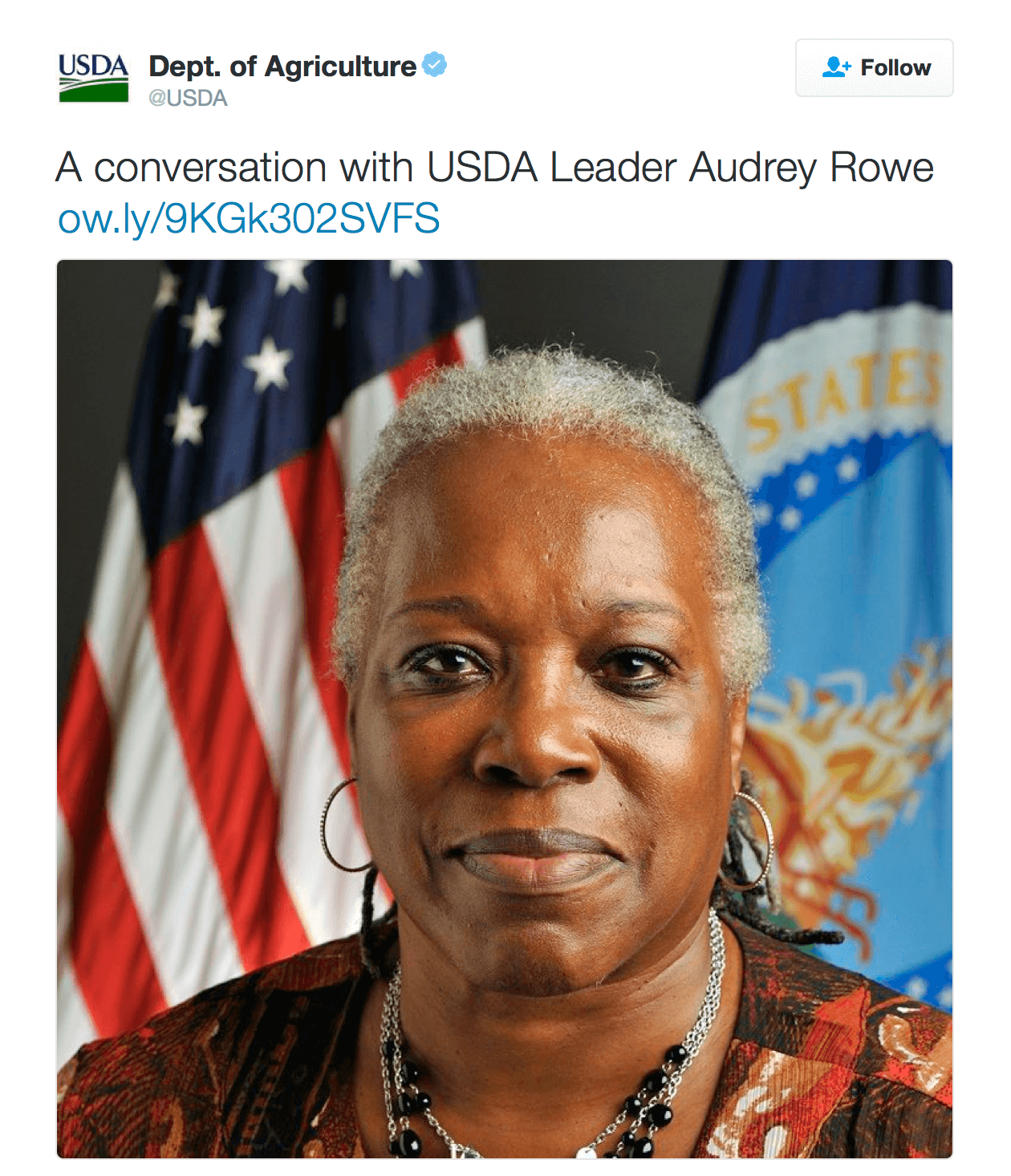



“I’m proud of an America that has the strength of being opening and welcoming. I’m proud of an America that... continues to press the case for a federal government, for federal agencies, for our country to be open to diversity; to be open to the sharing of stories; to understand the struggles of those who have come up the hard way; to create a better level of understanding so that over time we can build a trusting relationship that will empower USDA, the federal government and the United States of America.”
~Secretary Vilsack
Over the past eight years, under the leadership of Secretary Vilsack, USDA has forged a new era of civil rights both for our employees and for the communities we serve. Through coordinated outreach and better engagement, we’re forming new partnerships in diverse communities and regaining trust where it was once lost. This is most evident in the rising number of Hispanic and African-American farmers. Between 2007 and 2012, the United States saw a 12 percent increase in the number of black farmers and a 21 percent increase in Hispanic farmers. There is still much to accomplish, but we’ve made significant progress by prioritizing the following five core goals:
- Correcting Past Mistakes
- Improving Outreach to Expand the Breadth of Our Service
- Increasing Representation from Those We Serve
- Broadening Access to Economic Opportunity
- Spurring Cultural Transformation within the Department
You can read more about how each of these goals has been addressed and how they’re making progress toward a more equal and inclusive USDA by joining us throughout the month of August as we tell this important story. Follow along on usda.gov, on the USDA blog and by using #USDAResults, or catch up on Chapter VIII on our Medium site.


|

Agriculture Assistant Secretary for Civil Rights Dr. Joe Leonard (right) and an auditorium full of USDA employees laughed, listened and learned of the Reverend Al Sharpton’s insights about the topic of “Civil Rights in the Age of Obama.”
|

Fresh Foods Signal a Fresh Start for New Orleans’ Lower Ninth Ward
I’m really looking forward to celebrating National Farmers Market Week. Farmers markets play a key role in developing food systems that help local grow economies. They bring people together, create bridges between rural and urban communities and increase access to locally-grown fruits and vegetables, providing healthier options for consumers across the country.
USDA Market News Reporters Know Beef
The United States is the largest beef producer and one of the largest beef exporters in the world. In order to remain competitive, our Nation’s beef producers and everyone else in the supply chain need reliable data to evaluate market conditions, identify trends, make purchasing decisions, and monitor price patterns.
U.S. Forest Service Celebrates 50th Anniversary of the National Historic Preservation Act
Signed by President Lyndon Johnson fifty years ago, the National Historic Preservation Act marked a fundamental shift in how Americans and the federal government regarded the role of historic preservation in modern life.
Saving Florida’s Citrus Industry Through Collaboration and Innovation
The Florida citrus industry is under siege and the invader is a tiny bug called the Asian citrus psyllid (ACP). The ACP spreads a disease known as Huanglongbing (HLB) or citrus greening, and together they are destroying groves that have been cultivated by families for generations.
Report: Maintaining Sagebrush-Covered Landscapes Keeps Water on the Land for Ranchers and Wildlife
Removing invading conifer trees improves the health of sagebrush ecosystems, providing better habitat for wildlife and better forage for livestock. And now, new science shows these efforts may also help improve late-season water availability, which is crucial for ecosystems in the arid West.
When it Comes to Cotton, Texas Rules
Lone Star state growers are responsible for 56 percent of the U.S. acres planted to cotton and about 45 percent of the total cotton production. But how do we measure this crop accurately enough to make dependable forecasts for cotton yield and production? That’s where our measurement process, known as the objective yield kicks in.
A Conversation with USDA Leader Audrey Rowe
Audrey Rowe serves as the Administrator for the Food and Nutrition Service. Rowe oversees the nation’s 15 federal nutrition assistance programs, including the Supplemental Nutrition Assistance Program, Special Supplemental Nutrition Program for Women, Infants, and Children, and National School Lunch and School Breakfast programs.
Healthful Foods Could Be Just a Click Away: FNS Works to Bring Online Shopping to SNAP Purchases
Online grocery shopping has been an option for many busy American families for years. But for the 44 million Americans who use benefits from the Supplemental Nutrition Assistance Program (SNAP) to supplement their food budget, this option has not been available…yet.

Agriculture/Weather Experts from Kazakhstan Visiting USDA
A special delegation of agricultural and weather experts from Kazakhstan has been meeting in Washington this week with their counterparts at USDA for an information exchange. (Gary Crawford and Brad Rippey)
Actuality: How Does Cover Crop Use Connect to Farm Profits?
Rob Myers, University of Missouri agronomist and Regional Director, Extension Programs for the Sustainable Agriculture Research and Education program, reveals what farmer surveys say about how cover crops affect profits.
A "Gut" Approach To Honey Bee Health Study
The question of gut bacteria and its impacts on honey bee health is one under study by USDA scientists. (Rod Bain and Jay Evans of the Agricultural Research Service)

USDA Awards $2.2M to Remote Native Villages (Indian Country)
Once, rural Native communities were cut off from the rest of the world. Isolation and lack of opportunities drove many Natives to nearby cities where they often felt lost and out of place. But now, for the first time in history, the modern world is providing the means for Native people to remain in their homelands while also receiving the same high quality education and healthcare enjoyed by people in large cities.
Buffalo High student, agriculturist speaks up on farming, local food (Charleston Gazette-Mail)
Kelly Irvine, 15, had a much better behaved steer to show at the Putnam County Fair this year than last year. Robert, an almost-2-year-old, 1,209-pound Angus cross, was the perfect gentleman as she showed and sold him during this year’s fair in early July. Last year, her steer got a little nervous, and she took the brunt of it. Quite literally. “They can be very dangerous.
USDA Helping Veterans Get Involved In Farming (Fox Illinois)
The U.S. Department of Agriculture is aiming to help veterans get involved in farming. The program is giving veterans a financial headstart by allowing veterans to apply for farm loans with fewer stipulations. Officials say with so many veterans being from rural areas, this program is a great way to ensure financial stability. “In the 2014 farm bill there was some language introduced to help us get passed some of the eligibility criteria for veteran farmers.
Schools nurture students’ agriculture interests (USA Today)
A dozen students in Meagan Slates’ plant sciences class at Penn Manor High School in Millersville, Pa., cluster in small groups in the school’s greenhouse. In a previous class, they’d trimmed the meristems of coleus plants, and now they’re measuring new growth with rulers. The coleus are among the few plants in the greenhouse after the school’s annual plant sale, but a week earlier, it had been teeming with flowers, vegetables and bedding plants that the students had grown themselves.
Ag Secretary Encourages Unity in Agriculture (NAFB/Hoosier Ag Today)
Ag Secretary Tom Vilsack says the agriculture industry must do a better job speaking with one unified voice. The USDA chief recently said too much attention is paid to what divides the industry: whether you grow organic, conventional or whether GMOs are bad or not. But, he says farming is a profession that benefits the entire nation, even those who don’t realize it. “Every one of us that’s not a farmer, is not as farmer because we have farmers,” Vilsack said.
Hmong farmers getting help from UC Cooperative Extension to weather the drought – from UCANR (Planting Seeds)
After the Central Valley Hmong Agriculture radio show aired, the phones at the UC Cooperative Extension office in Fresno County were buzzing non-stop with farmers anxious to apply for state grants to improve irrigation systems and energy efficiency. Michael Yang, UCCE Hmong agricultural assistant, has hosted the one-hour show each Tuesday afternoon on KBIF 900 AM for 19 years. “Sometimes we don’t see the farmers that often. They are busy on the farm,” Yang said. “But when they hear something (important) like this on the radio, they show up.”
These New Yorkers Quit Their Desk Jobs to Run a Farm—On a Brooklyn Rooftop (Fortune)
When you hear the word “entrepreneur,” what image comes to mind? A hoodie-clad Stanford grad pitching his new tech app? An ex-investment banker opening his own shop? What about a thirtysomething woman growing vegetables on a rooftop? Anastasia Cole Plakias, co-founder and vice president of Brooklyn Grange, fell into farming somewhat serendipitously. An aspiring food journalist, she met the founders of the soon-to-be-legendary pizzeria Roberta’s in 2009 while reporting on the blossoming Brooklyn food scene.
 





|

